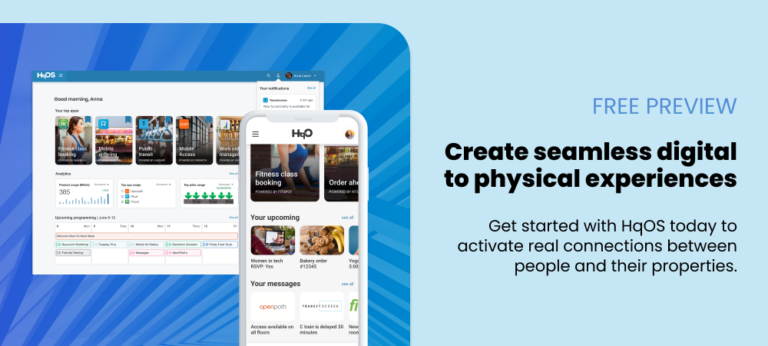Big data has transformed the commercial real estate industry, as landlords and property teams now have access to significant end-user insights through an influx of new technology partners. However, merely sourcing this data isn’t enough to set an individual or firm apart in the office sector. Real estate investors, brokers, agents, and managers also need a way to glean actionable insights from the data. That’s where real estate analytics capabilities come in.
Real estate analytics software helps industry professionals sift through all of the information that’s available in order to find the details that are truly meaningful. Professionals can then use these details to make more informed (and hopefully more profitable) decisions. Such software is essential to any real estate analyst’s work, and its insights can be beneficial to all of your portfolio’s key stakeholders.
Getting Competitive with Commercial Real Estate Analytics
The data that commercial real estate analytics programs produce doesn’t just come from traditional sources — such as transaction, appraisal, and demographic trend data. Rather, advanced programs can also pull from the internet of things (IoT) devices, end-user engagement, and other, more granular data sources to create a comprehensive picture about what’s going on — and what works — in the modern workplace.
Once data is collected, artificial intelligence and deep learning make it possible to identify opportunities and trends more quickly. These functionalities not only allow for more in-depth analysis and reporting, but provide real-time feedback that can help teams adjust and adapt based on new findings.
Moreover, incorporating data science in real estate decisions is helpful across the board. In fact, every aspect of a commercial real estate firm’s operations can benefit from advanced data analytics, such as:
- Deals & Acquisitions: Sourcing larger datasets makes it easier to identify the most promising opportunities, and having a better command of the data provides for more rigorous due diligence and stronger negotiating positions.
- Portfolio & Risk Management: Predictive analytics help identify trends and project maintenance needs. Real-time monitoring of a portfolio risk makes it possible to consistently maintain tighter risk controls.
- Operational Processes: Real-time data gives a constantly current overview, and ensures accurate investment accounting. Reports can also be automated through machine learning.
- Tenant Engagement: By collecting information on how end-users interact with a building or a given space, property teams can tune into the specific amenities and services that their tenants actually want — thus generating office value through customer satisfaction and lease retention.
In short, commercial data analytics are the key to identifying trends and increasing your office’s profitability.
Variations in Real Estate Analytics Software
Many commercial real estate companies develop software solutions. Some of these real estate analytics softwares are narrowly focused on one aspect, while others offer a more comprehensive approach. This means that determining which solution is best for property teams depends on their portfolio’s specific needs.
One of the most well-known solutions is Real Capital Analytics. Real Capital Analytics has extensive data that’s sourced from many places, but the software’s primary focus is on acquisitions. The software offers different solutions for investors, owners, brokers, agents, lenders, originators, valuers, appraisers, and service providers. In all of its variations, however, there’s a consistent focus on assessing markets, sourcing opportunities, and executing transitions — in other words, conducting successful acquisitions. Another organization is CoStar, which is a much more extensive software solution. For taking a comprehensive approach to using predictive analytics in real estate, Costar offers information on properties, leases, listings, comparables, tenants, analytics and more.
Though there are many more analytics software solutions available in the market, aggregating all the data from a building’s technology stack can be a tricky and daunting task. In the next section, we discuss more resources for understanding the office’s new digital analytics needs.
How to Become a Real Estate Analyst
Though many large commercial real estate firms have a real estate analyst as an official company role, small firms without a dedicated person can also take advantage of commercial real estate insights. For anyone to become an effective real estate analyst, they simply need the best real estate analytics software available and knowledge of the real estate market.
Depending on a person’s role, there are several reputable real estate data analytics courses and resources that can help break down the big data. A few examples of these are as follows:
- Real Estate Investment Certificate (Harvard Extension School)
- Real Estate Finance (UCLA Extension School)
- Professional Certificate Program in Real Estate Finance & Development (MIT Professional Education)
- Real Estate Finance and Investment Courses (NYU School of Professional Studies)
- Global Financing Solutions (Coursera)
More importantly, if property teams can’t take advantage of such courses, partnering with the right technology experts can place advanced data collecting and analyzing capabilities directly in the palm of their hands. Tenant experience software — such as what is available through the HqO platform — can collect data from multiple sources, organize it, and even compare it to other buildings to give teams a competitive edge.
Gathering the Best Real Estate Analytics: A CRE Operating System
Of all the courses, resources, and software solutions available, the best real estate analytics solution is an end-to-end operating system. Since digital transformation is fairly new to CRE, finding meaningful metrics about your building can be few and far between — and even more difficult to organize. Luckily, the HqOS™ end-to-end operating system provides CRE owners with a leap in the right direction. The three layers of HqOS — which include our Marketplace, Tenant Experience Platform, and the Digital Grid™ — work seamlessly together to produce compounding positive results for any portfolio.
Our growing Marketplace of best-in-class technology partners — which can be accessed through the Tenant Experience Platform — enables landlords to activate more of their building features, while simultaneously providing tenants with a better experience and property managers with a higher volume of rich data. The Digital Grid then takes these activations a step further, serving as a connected and streamlined analytics offering that can collect tenant behavior, amenities, technologies, and building data all in a single location. By centralizing and structuring data within our CRE-specific data model, it helps owners and operators uncover insights, take action to differentiate their assets, and make intelligent decisions across their portfolio. It can also help benchmark your building’s performance against others to accelerate best-in-class experiences for any tenant.
Now that you know how invaluable commercial real estate analysis software is, it’s time to try it out for your own portfolio. Learn more about HqOS™ and schedule a free demo today.




